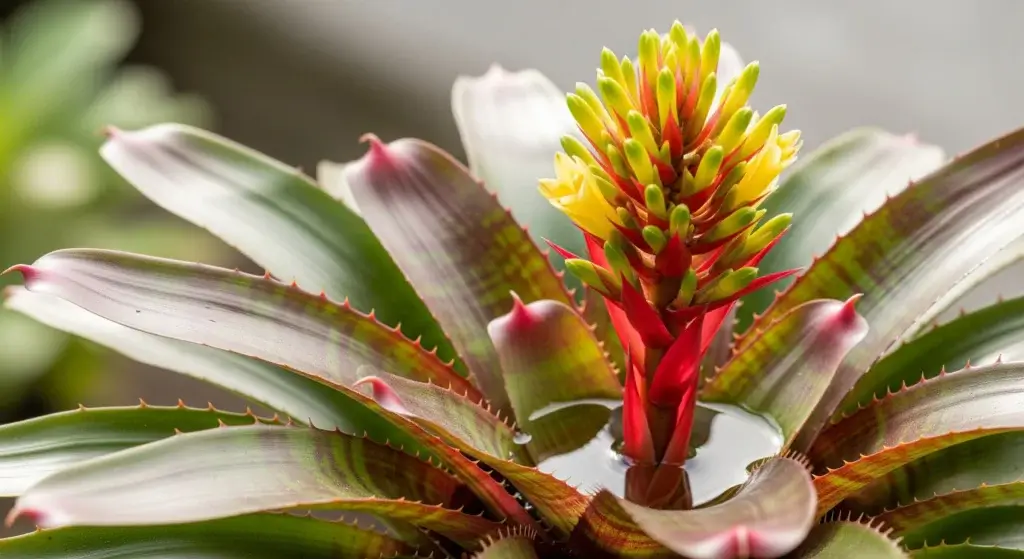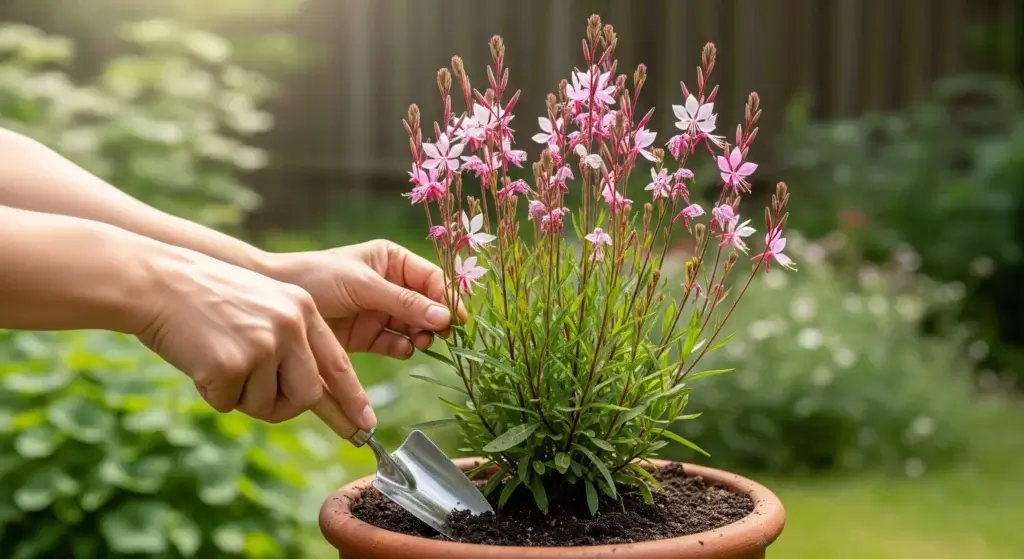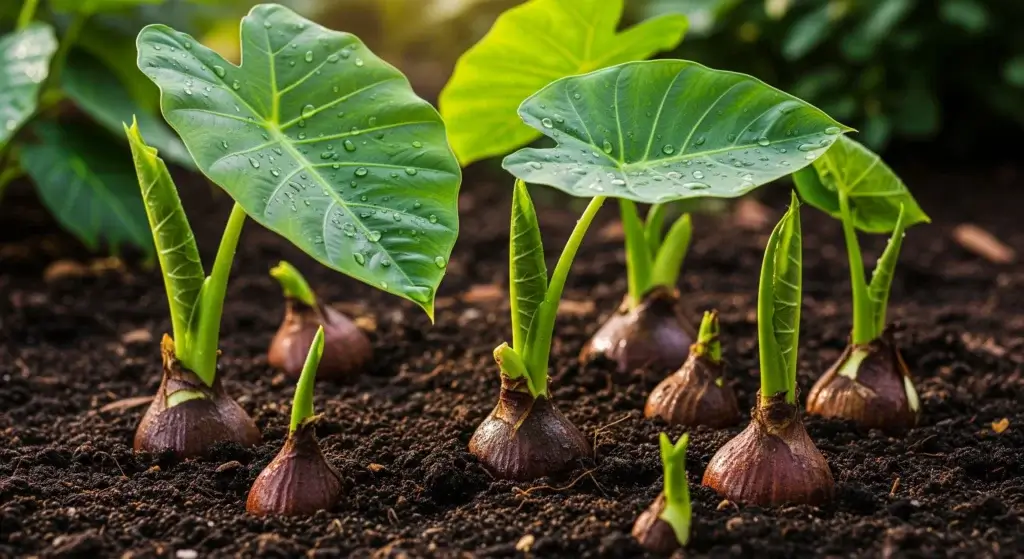
Want fat, juicy beets? It takes more than tossing seeds in dirt and hoping for the best.
Beets need the right nutrients at the right time.
This quick guide shows you exactly which fertilizers to use and when—whether you’re a garden pro or just got dirt under your nails.
Think of it as cheat codes for max beet power.
Understanding Beetroot Nutritional Requirements
Beets don’t grow like most root veggies.
While you might think they just need stuff to help roots bulk up, beets play by their own rules.
First, they need to grow big leafy tops—that’s where the real root magic starts.
More leaves = more photosynthesis = more energy = bigger beets.
So yeah, leaf growth is the real MVP here.
Here’s the quick nutrient breakdown:
- Nitrogen (N): Top priority. It’s what makes the leaves go wild, which is exactly what beets want early on.
- Phosphorus (P): Helps roots and general plant health, but beets don’t obsess over it like some other root crops.
- Potassium (K): Keeps the plant tough and healthy, but again—not the star of the show.
So, if you’re feeding your beets like they’re carrots, you’re doing it wrong.
Think more “spinach energy” up top to grow that underground beet booty.
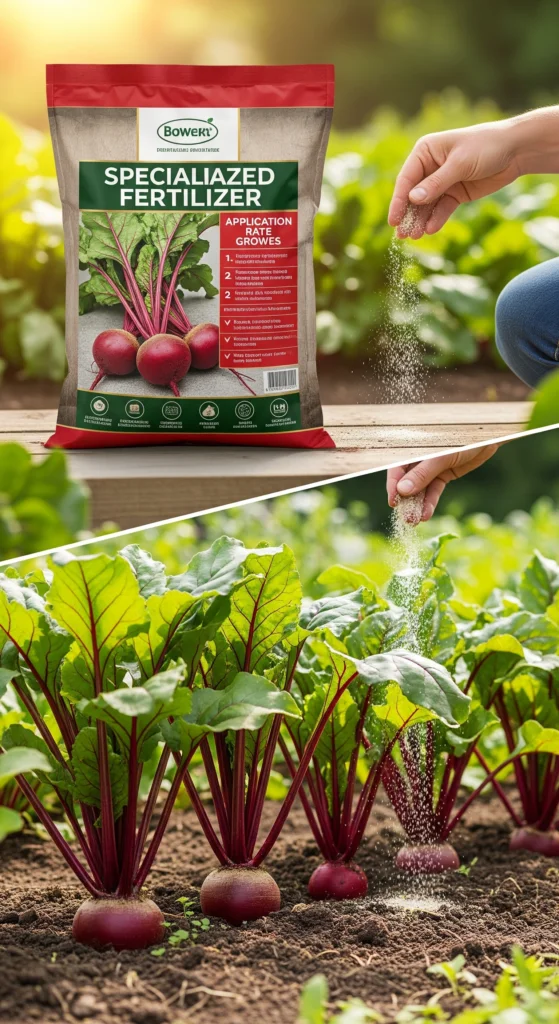
Best Fertilizer Types for Beetroot Growth
1. Balanced NPK fertilizers
Go for a 10-10-10 or 5-5-5 mix. That’s equal parts nitrogen, phosphorus, and potassium—like giving your beets a balanced meal.
- Before planting: Sprinkle 3 pounds (about 1.5 kg) per 100 square feet, 7 days ahead of time.
- After planting: Side-dress with 3 ounces (85g) one to three times during the growing season. Basically, feed them like you’d top up snacks during a Netflix binge.
2. Organic fertilizer options
If you’re into natural stuff, there are solid organic picks:
- Blood meal: Sounds creepy, works great. It’s high in nitrogen and perfect early on when the plant’s focused on leafy growth.
- Worm castings & seaweed extract: These are slow-release, gentle boosters. Worm poop (yep) adds nutrients and helps the soil breathe. Seaweed brings the trace minerals and plant zen.
- Compost: The OG of organic. Toss in some well-rotted compost to feed your plants and improve soil texture.
3. Specialty root vegetable fertilizers
Some fertilizers say they’re “for root crops” and are high in phosphorus and potassium but low in nitrogen.
That can help root growth, but remember—beets still need solid leaf growth first.
So if you go this route, tweak your timing or mix it with something more nitrogen-heavy early on.
Optimal Soil Conditions for Fertilizer Effectiveness
Before you dump fertilizer on your beets, check the soil—because even the best plant food won’t work if the dirt’s not dialed in.
1. Soil pH: Don’t skip this
Beets like their soil slightly acidic to neutral—pH 6.0 to 6.8 is the sweet spot.
They can handle up to 7.0, but beyond that, nutrients get locked up like a Netflix account with too many users.
If the pH is off, your fertilizer won’t do squat.
2. Test before you feed
Do a soil test. Seriously. It tells you:
- What the pH actually is
- How much nitrogen, phosphorus, and potassium are already in there
- How much organic matter you’ve got
- If the soil drains like a dream or holds water like a sponge
With that info, you’ll know exactly what kind of fertilizer to use and how much to apply—no guesswork, no wasted money, no sad beets.
Fertilizer Application Timeline
Beets don’t like to guess when dinner’s coming.
Stick to this schedule to keep them happy and growing strong.
7 days before planting
Mix your fertilizer into the soil a week before planting.
That gives nutrients time to settle in and be ready when seeds start waking up.
6 weeks after planting
This is when your beets start pushing out those leafy tops.
Hit them with more nitrogen now—it’s like giving them a green smoothie during a growth spurt.
Mid-season – height check = snack time
When your beet leaves hit about 6 inches tall, toss in a second round of fertilizer.
It’s like a mid-level XP boost. Helps the plant push energy down into the root zone.
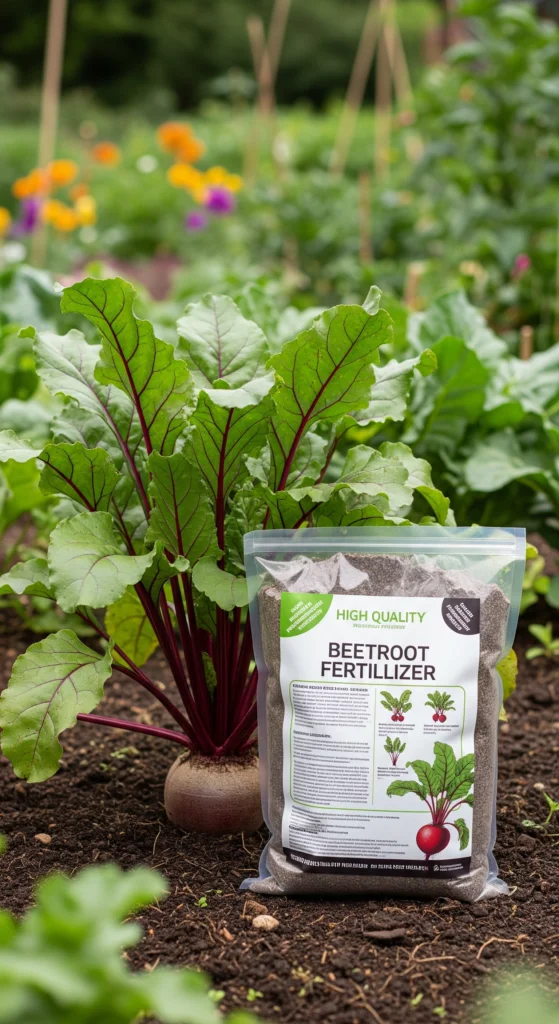
Common Fertilizing Mistakes to Avoid
Even the best fertilizer can backfire if you don’t use it right.
Here are the top mess-ups that can wreck your beet game—and how to dodge them.
Over-fertilization
More isn’t always better.
Dump too much fertilizer, and you’ll grow a jungle up top with puny roots underneath.
Beets will go full Hulk mode on leaves but forget they’re supposed to grow a root.
Use just enough—not too little, not too much. Think “Goldilocks,” but for veggies.
Late-season nitrogen
Nitrogen’s great early on (remember, it powers leaf growth), but using it late in the season is like giving coffee to a kid before bed.
It makes the plant go nuts on leaf growth just when it should be focusing on building that fat, juicy root.
Cut off the nitrogen when your beets start bulking up.
Neglecting soil moisture
After you fertilize, water your plants. Always.
No moisture means the nutrients just sit there instead of reaching the roots.
It’s like putting food on the table and not letting anyone eat. Dry soil = hungry beets = zero progress.
Organic vs. Synthetic Fertilizers: Making the Right Choice
Choosing how to feed your beets is kinda like picking between home-cooked meals and fast food.
Both have pros. Here’s the breakdown:
Organic fertilizer benefits
- Feeds plants slowly over time—no rush, just steady gains
- Makes soil better by boosting microbes and structure
- Won’t burn your plants if you overdo it
- Better for the planet
- Builds long-term soil health like a savings account
Synthetic fertilizer advantages
- Exact nutrient levels—no guessing
- Works fast, like plant Red Bull
- Cheap for big gardens
- Easy to use and measure
- Same results every time
Hybrid approach
Smart gardeners mix it up.
They use compost or worm castings to build healthy soil long-term, then toss in some synthetic fertilizer when their beets need a quick boost—like during early leaf growth or when roots start bulking up.
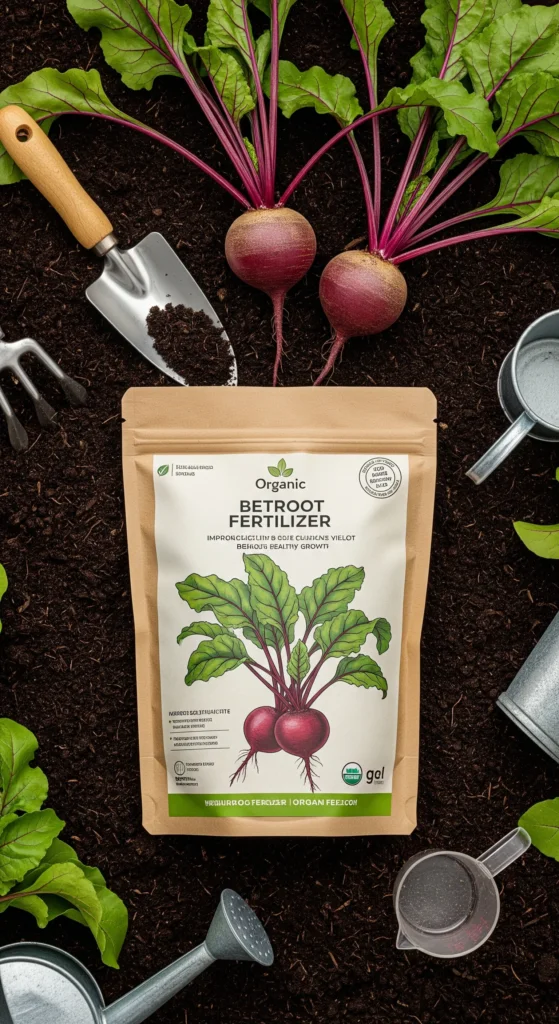
Regional Considerations and Climate Factors
Where you live totally changes how you should feed your beets. Rain, soil, and season length all play a role.
Here’s how to work with what you’ve got:
Lots of rain? up your fertilizer game
If you’re in a rainy spot, nutrients wash away fast.
That means your beets might go hungry unless you add more fertilizer or feed them more often.
Think of it like trying to stay full on snacks during a water park trip—everything’s getting rinsed off.
Short growing season? go fast mode
If your growing season is short, like blink-and-it’s-fall, use quick-release fertilizers.
Your beets need fast fuel to grow in time.
No slow-build stuff here—go straight for the plant version of an espresso shot.
Know your dirt type
- Clay soil: Holds nutrients well but drains like a clogged sink. Mix in compost to loosen it up.
- Sandy soil: Nutrients disappear fast. Use small, frequent fertilizer doses or your beets will starve.
- Loamy soil: Jackpot. Great drainage, holds nutrients, plays nice with beets. Keep doing what you’re doing.
Monitoring Plant Health and Adjusting Fertilization
Beets won’t text you when something’s wrong, but they do show signs.
Here’s how to read them and adjust your fertilizer game.
Signs your beets are on point:
- Leaves are dark green and growing strong
- Stems stand tall, not floppy or stretched out
- You see the root starting to puff up at the soil surface
- No yellowing, no drama—just steady growth
Signs your beets are hungry:
- Low Nitrogen: Older leaves turn yellow, plants stop growing like they just gave up
- Low Phosphorus: Leaves go purple (not in a cool way), roots stay small
- Low Potassium: Leaf edges turn brown and crispy, plants get sick more easily
Signs of over-fertilization
- Beets grow massive leaves but barely any root
- Plants get soft and squishy—not in a good way
- White crust (salt buildup) shows up on the soil
- Big tops, lame roots—like a bodybuilder who skipped leg day
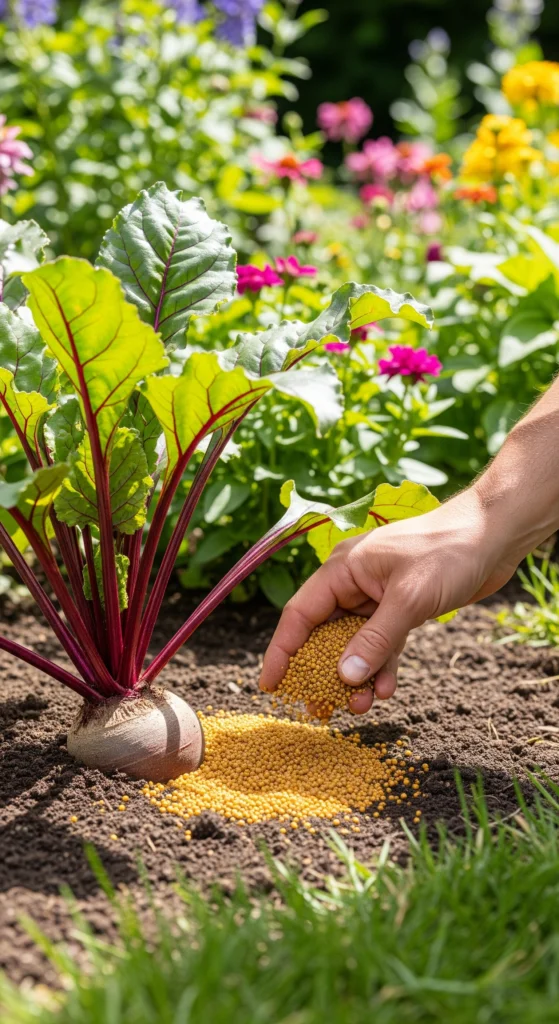
Sustainable Fertilization Practices
Feeding your beets is cool. Ruining your soil long-term? Not so cool.
Here’s how to fertilize in a way that keeps your dirt—and the planet—happy.
Build healthy soil for the long haul
Wanna grow great beets next season too? Do this:
- Toss compost in regularly
- Grow cover crops (like clover or rye) between seasons
- Don’t till the soil like crazy—keep it chill
- Switch up what you plant so pests don’t throw a party
Fertilize smart with water
Only fertilize when the soil’s moist—not bone dry or soaking wet.
Too dry? Nutrients won’t move. Too wet? They’ll just wash away and pollute waterways.
Aim for that Goldilocks zone.
Healthy plants = Fewer pests
Beets that get the right nutrients fight off bugs and disease better.
That means less spraying and fewer problems.
Basically, strong plants are their own security system.
Wrap-Up
To grow awesome beets, you need to feed them right—especially with enough nitrogen early on to build big leaves that power root growth.
Use organic, synthetic, or both—just match it to your soil and climate.
Start with a soil test. Pick the right fertilizer. Watch your plants and adjust as needed. Don’t overdo it.
Stick to the basics, pay attention, and you’ll end up with bold, tasty beets that prove you know your stuff. Gardening’s part science, part vibes—trust both.

